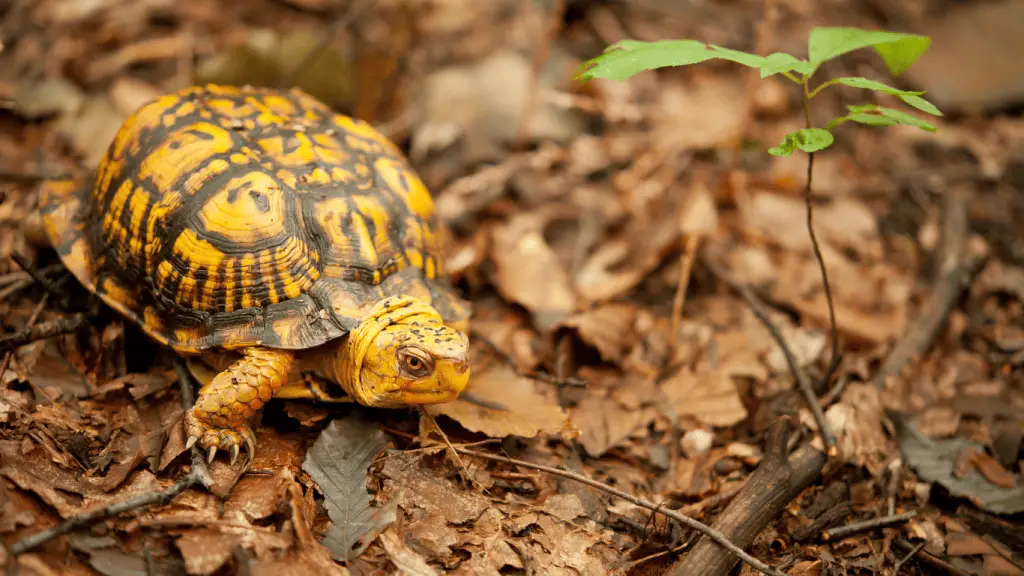The Woodland Box Turtle is a fascinating reptile commonly found in the wild. These turtles are known for their high, domelike carapace with a varied color pattern of yellow, orange, or olive on a dark background. They are also known for their slightly hooked upper mouth and webbed toes.
If you want to learn more about Woodland Box Turtles, you have come to the right place. This comprehensive guide will cover everything you need to know about these fantastic creatures.
From their physical characteristics and habitat to their behavior and diet, we will provide you with all the information you need to become an expert on Woodland Box Turtles.
Whether you are a nature lover, a student, or simply curious about these fascinating reptiles, this guide will provide knowledge and insights. So, let’s get started and explore the wonderful world of Woodland Box Turtles together!
Understanding Box Turtles

Species Overview
Box turtles are a species of reptile that belong to the genus Terrapene. They are commonly found in North America and are known for their unique box-like shell that can be closed completely to protect them from predators. There are several subspecies of box turtles, including the Eastern box turtle, the Three-toed box turtle, and the Gulf Coast box turtle.
The box turtle is a long-lived species, with some individuals living up to 100 years. They are slow to mature and have few offspring per year, which makes them vulnerable to population decline. Box turtles are omnivores, feeding on various foods such as fruits, insects, and small animals. They are also known for their ability to hibernate during the winter months.
Subspecies Identification
There are several subspecies of box turtles, each with unique physical characteristics. The Eastern box turtle, for example, has a high-domed shell that is typically brown or black with yellow or orange markings. On the other hand, the Three-toed box turtle has a flatter shell and only three toes on each foot. The Gulf Coast box turtle has a more elongated and narrow shell than other subspecies.
Identifying the subspecies of box turtles you are observing is essential, as this can provide valuable information about their habitat and behavior. Additionally, some subspecies are protected by law, and capturing or harming them is illegal.
Woodland Box Turtle Features
The Woodland box turtle, also known as the Eastern box turtle, is a subspecies of the typical box turtle. They are typically found in the eastern United States, from Maine to Florida and from the Great Lakes to Texas.
The Woodland box turtle has a high, domed shell, typically brown or black, with yellow, orange, or olive markings. The female’s eyes are brown, while the males are red. They have four toes on each hind foot, a slightly hooked upper mouth, and slightly webbed toes.
Woodland box turtles are a threatened species due to habitat loss, fragmentation, and road mortality. Protecting these turtles, such as avoiding driving over them on the road and protecting their habitat, is essential.
Habitat and Distribution

Woodland Habitats
The Woodland Box Turtle is a terrestrial turtle that is found in a variety of habitats. Still, it is most commonly found in deciduous forests, where it can find shelter in leaf litter and underbrush. These turtles prefer habitats with a moderate amount of shade, and they are often found in areas with a mix of open spaces and dense vegetation. They can also be found in fields and meadows adjacent to woodlands.
Water Sources
Woodland Box Turtles require access to water, but they do not spend as much time in the water as other species of turtles. They are often found near small streams, ponds, and other bodies of water, where they can drink and soak in the sun. However, they spend most of their time on land and do not swim as much as other aquatic turtles.
Illinois and Beyond
The Woodland Box Turtle is found throughout the eastern United States, from Maine to Florida and as far west as Texas. In Illinois, they are found in the southern part of the state, where they are most commonly found in the Shawnee National Forest. They are also found in other wooded areas throughout the state, but their populations have declined due to habitat loss and fragmentation.
In addition to Illinois, Woodland Box Turtles can be found in various habitats throughout their range. They are often found in deciduous forests, but they can also be found in other types of woodlands and fields and meadows adjacent to woodlands. They require access to water but do not spend as much time in the water as some other species of turtles.
Overall, the Woodland Box Turtle is a fascinating and essential species that play a vital role in the ecosystems where it is found. By understanding its habitat and distribution, we can work to protect this species and ensure that it continues to thrive in the wild.
Diet and Eating Habits
The Woodland Box Turtle is an omnivorous species that has a diverse diet. It feeds on various foods, including fruits, vegetables, invertebrates, and carrion. In this section, we will discuss the dietary habits of the Woodland Box Turtle, including its carnivorous tendencies, fruits, and invertebrates.
Carnivorous Tendencies
Although the Woodland Box Turtle is omnivorous, it does have some carnivorous tendencies. It feeds on various invertebrates, including earthworms, snails, slugs, and insects. These invertebrates provide the turtle with essential nutrients, such as protein and calcium, necessary for its growth and development.
However, it is essential to note that the Woodland Box Turtle is not a strictly carnivorous species. It also feeds on various fruits and vegetables, which comprise a significant portion of its diet.
Fruits
Fruits are an essential part of the Woodland Box Turtle’s diet. They provide the turtle with essential nutrients, including vitamins and minerals necessary for its growth and development. Some of the fruits that the Woodland Box Turtle eats include strawberries, bananas, and apples.
It is important to note that not all fruits are suitable for the Woodland Box Turtle’s diet. Fruits with high acidity, such as oranges, should be avoided as they can cause digestive problems in the turtle.
Invertebrates
In addition to fruits, the Woodland Box Turtle feeds on various invertebrates in addition to fruits. These invertebrates include earthworms, snails, slugs, and insects. Invertebrates provide the turtle with essential nutrients, such as protein and calcium, necessary for its growth and development.
It is important to note that not all invertebrates are suitable for the Woodland Box Turtle’s diet. Insects high in fat, such as mealworms, should be avoided as they can cause health problems in the turtle.
Physical Characteristics
The Woodland Box Turtle is a small to medium-sized turtle with a high-domed, rounded, hard upper shell called a carapace. The carapace is usually brown or black, measuring up to 8 inches long. The turtle’s plastron, or bottom shell, is hinged and can be closed tightly to protect the turtle from predators.
Carapace
The carapace of the Woodland Box Turtle is highly domed and can have a variety of patterns and markings. The carapace is usually brown or black and smooth or slightly rough. The carapace is also highly durable and can withstand various environmental pressures. The Woodland Box Turtle’s carapace is one of its most distinctive features and can be used to identify the species in the wild.
Coloration
The Woodland Box Turtle’s coloration can vary greatly depending on the individual and the region in which it lives. The turtle’s carapace is usually brown or black and can have a variety of patterns and markings. Some Woodland Box Turtles have yellow markings on their feet and faces, while others have no yellow markings at all. The vivid, orange, and yellow markings on the turtle’s dark brown shell distinguish it from other box turtles, as do the four toes on its hind feet.
The Woodland Box Turtle’s coloration is a necessary adaptation that allows it to blend in with its surroundings and avoid predators. The turtle’s coloration can also vary depending on age and sex, with males often having brighter and more vibrant colors than females.
Behavior and Lifestyle
Woodland box turtles are fascinating creatures with unique behaviors and lifestyles. In this section, we will explore some of their most attractive traits.
Basking and Mating
Like many other turtle species, woodland box turtles enjoy basking in the sun. They often spend hours soaking up the rays, especially in the morning when the sun is not too hot. Basking helps regulate their body temperature and aids in digestion.
During the mating season, male box turtles will become more active and will often be seen wandering in search of a mate. They will use their sense of smell to locate a female and engage in a courtship ritual involving circling and nipping at her legs. Once they have mated, the female will lay her eggs in a shallow nest she has dug in the soil.
Terrestrial Living
Woodland box turtles are primarily terrestrial, meaning they spend most of their time on land. They are excellent climbers and can often be found perched on logs or rocks. They are also skilled burrowers and will dig shallow burrows in the soil to escape extreme temperatures or to hibernate during the winter.
Box turtles are solitary creatures and prefer to live alone. They will defend their territory if necessary and often retreat into their shell if threatened. They are also known to be very shy and will often hide if they sense danger.
Conservation Status
The Woodland Box Turtle (Terrapene carolina Carolina) is listed as a vulnerable species by the International Union for Conservation of Nature’s Red List of Threatened Species. The population of the Woodland Box Turtle has declined due to habitat loss, fragmentation, and degradation. The illegal pet trade, road mortality, and predation threaten the species.
Conservation efforts have been initiated to protect the Woodland Box Turtle from further decline. The following are some of the conservation measures that have been taken:
- Habitat Protection: The preservation of suitable habitats is essential for the survival of the Woodland Box Turtle. Efforts are being made to protect and restore the species’ habitats, such as maintaining forested areas, reducing the impact of human activities, and creating buffer zones around the habitats.
Population Monitoring: Regular monitoring of the population of the Woodland Box Turtle is crucial for understanding the species’ status and implementing effective conservation measures. Researchers use radio telemetry, mark-recapture, and visual surveys to monitor the population.
- Education and Awareness: Raising awareness among the public about the importance of the Woodland Box Turtle and its conservation is essential. Educational programs, public outreach campaigns, and community involvement are some metused to increase awareness.
- Legal Protection: The Woodland Box Turtle is protected under state and federal laws, such as the Endangered Species Act, which prohibits the take, sale, or trade of the species without a permit. The laws also regulate the collection and transport of the species.
- Rehabilitation and Release: Injured or sick Woodland Box Turtles are rehabilitated and released back into the wild. Rehabilitation centers provide medical care, food, and shelter until the turtles are healthy enough to be released.
Box Turtles as Pets
Woodland Box Turtles are becoming increasingly popular pets due to their docile nature and unique personalities. However, before deciding to bring one home, it is essential to understand the care requirements and responsibilities of owning a Box Turtle.
Space Requirements
Box Turtles require adequate space to live comfortably and thrive. A single adult Box Turtle should have a minimum enclosure size of 4 feet by 4 feet, with a height of at least 12 inches. The enclosure should provide both a dry and water area for the turtle to soak in. The water area should be large enough for the turtle to submerge fully.
It is important to note that Box Turtles are not suitable for small living spaces such as apartments or small rooms. They need ample space to move around and explore their environment.
Environmental Control
Box Turtles require specific environmental conditions to stay healthy. They need a basking area with a temperature range of 85-90°F and a more relaxed area with a temperature range of 70-75°F. The enclosure should also have a UVB light source to provide the turtle with essential vitamins and minerals.
Maintaining proper humidity levels is also crucial for Box Turtle’s health. The enclosure should have a humidity level of 60-80%. This can be achieved through regular misting and providing a moist substrate.
It is essential to regularly monitor the temperature and humidity levels inside the enclosure to ensure they remain within the appropriate range.
Box Turtles and Other Animals
Box turtles are fascinating creatures that are often kept as pets. However, it is essential to remember that they are not the only animals that can be found in their natural habitat. Box turtles share their environment with various other animals, including amphibians, birds, and mammals.
Amphibians are an essential part of the ecosystem that box turtles inhabit. These animals play a vital role in maintaining the environment’s health by controlling insect populations and providing food for other animals. Some of the most common amphibians in the same habitat as box turtles include frogs, toads, and salamanders.
Frogs are perhaps the most well-known amphibians and can be found in various environments. Some species of frogs prefer to live near water, while others are adapted to live in more arid environments. Toads are another type of amphibian that can be found in the same habitats as box turtles. These animals are known for their bumpy, warty skin and distinctive croaking call.
Salamanders are another type of amphibian that can be found in the same habitats as box turtles. These animals are often mistaken for lizards due to their long, slender bodies and ability to regenerate lost limbs. However, salamanders are more closely related to frogs and toads than lizards.
In addition to amphibians, box turtles also share their environment with various birds and mammals. Some of the most common birds found in the same habitats as box turtles include songbirds, woodpeckers, and raptors. Mammals found in the same habitats as box turtles include squirrels, raccoons, and opossums.
FAQ
What are the essential components of a woodland box turtle’s habitat?
Woodland box turtles require a habitat that mimics their natural environment. The habitat should include a mix of sunny and shady areas and a water source such as a shallow pond or bowl. The substrate should mix soil, sand, and leaf litter to provide a soft and moist surface for the turtle to burrow into. It’s important to provide hiding places such as logs, rocks, and plants to create a sense of security for the turtle.
How often should a woodland box turtle be fed, and what should their diet consist of?
Woodland box turtles are omnivores and require a balanced animal and plant matter diet. Adult turtles should be fed every other day, while juveniles should be fed daily. Their diet should include various fruits, vegetables, and protein sources such as insects, worms, and snails. It’s essential to provide a calcium supplement to prevent shell deformities.
What are the common health issues that woodland box turtles may face?
Woodland box turtles can be prone to respiratory infections, shell rot, and parasites. Signs of illness include lethargy, lack of appetite, discharge from the eyes or nose, and abnormal behavior. It’s essential to seek veterinary care if these symptoms are observed.
What is the lifespan of a woodland box turtle?
Woodland box turtles can live up to 40 years in captivity with proper care. Their lifespan may be shorter in the wild due to predation, habitat loss, and other environmental factors.
What is the ideal temperature range for a woodland box turtle’s habitat?
Woodland box turtles require a temperature range of 75-85°F during the day and 65-75°F at night. Basking areas should be provided to allow the turtle to regulate its body temperature. It’s essential to monitor the temperature and humidity levels in the habitat to ensure they are within the appropriate range.
What are some common behaviors and habits of woodland box turtles?
Woodland box turtles are generally solitary animals and prefer to spend most of their time on land. They are active during the day and retreat into their shells if threatened. They are also known to hibernate during the winter months. Providing a safe and secure habitat is essential to allow the turtle to exhibit natural behaviors.




Leave a Reply